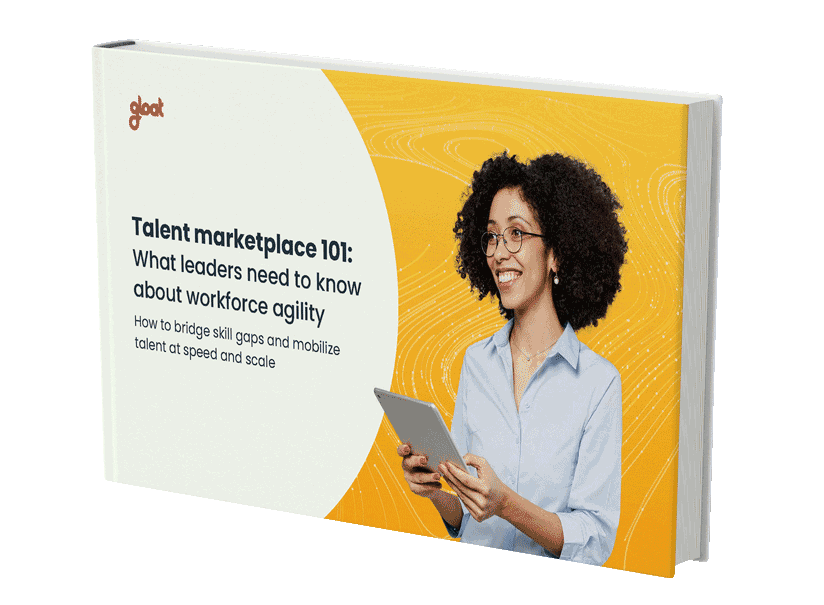Talent marketplace: how it can transform HR management
Understand what a talent marketplace is, its key benefits, and how it works

For a long time, most talent management rules were simple. Employees were hired to do a specific job, and they had one manager who was, in turn, being managed by someone else in the same function—all the way to the top. Everyone stood on one rung of the same vertical ladder, and ultimately all employees had the same choice: climb up or step off.
Since there wasn’t much room to challenge the status quo or think outside of the box, talent management tools weren’t built for agility.
Today, HR is a much more strategic role, and the same set of tools therefore no longer suffice. Modern people leaders aren’t just filling out spreadsheets; they’re revolutionizing the way we work and transforming the employee-employer relationship. They need transformative solutions to unlock agility, prepare for the future of work, and ensure they have the right skills in the right place. And that’s where talent marketplaces come into play.
What is the talent marketplace?
A talent marketplace is an AI-driven digital platform that matches employees with internal opportunities based on their skills, interests, and career goals. It helps organizations fill roles faster, increase retention, and promote internal mobility by making workforce capabilities visible and actionable.
Talent marketplaces aren’t an upgraded version of traditional HR technology. They’re not human capital management platforms 2.0.
You don’t have to look far to see how marketplace dynamics have already transformed other aspects of our daily lives. We don’t need to call for a cab anymore or rely on hotels when we’re going out of town; instead, Uber takes us where we want to go and Airbnb helps us find a place to stay.
Talent marketplaces utilize the same model to transform the way we work, giving HR and business leaders on-demand access to qualified candidates who can be deployed to new projects and roles.
How does a talent marketplace work?
A talent marketplace works by using AI or algorithms to match employees with internal job openings, projects, or mentorships based on their skills and interests. It collects workforce data, analyzes fit, and recommends opportunities, enabling companies to optimize internal talent use and reduce hiring costs.
While external hiring was long thought to be the dominant way to fill emerging skill needs, forward-thinking companies are increasingly prioritizing internal candidates as the hiring landscape gets more competitive. Talent marketplaces facilitate internal mobility and enable leaders to find the skilled job candidates they’re searching for without needing to look outside of their organizations.
What are the key benefits of using a talent marketplace?
There’s no denying that implementing a talent marketplace is a major change. Schneider Electric was among the first of the pioneering organizations that launched their platform, and their VP of Digital Talent Transformation, Jean Pelletier, goes so far as to say, “It’s a complete rewrite of HR. You need to think differently about speed and how to go deep and broad in an organization using AI.”
While it might be a major change, the talent marketplace also comes with some game-changing benefits:
Future-fit upskilling and reskilling
Since the World Economic Forum predicts that upskilling will be crucial for the 78 million new jobs created by 2030, the clock is ticking when it comes to building future-fit skills. In the past, L&D initiatives often failed to make an impact because they were missing a critical piece of the puzzle: experiential learning.
There’s no doubt that the right skill-building approach makes an impact. 93% of CEOs who have introduced upskilling programs noted that they’ve seen an improvement in retention and productivity.
To maximize the efficacy of your skill-building strategy, employees need a chance to put what they’re learning into practice. Talent marketplaces take training to the next level by matching people to projects, gigs, and mentorships that will provide the hands-on experience that was once lacking.
Unlocking agility
Agility has emerged as the make-or-break factor for businesses in recent years. And the importance of reacting and evolving quickly is only going to increase in the age of AI.
While nine out of ten executives believe organizational agility is critical to business success, most leaders don’t have what they need to unlock it.
Namely, leaders lack full visibility into their workforces’ skills so that talent can be redeployed at a moment’s notice to meet evolving priorities. Talent marketplaces put these rapid pivots and fast-paced redeployments well within reach.
Improve engagement and retention
If your people don’t see a future with your organization, they’re going to build one somewhere else. 52% of exiting employees say their manager could have done something to prevent them from leaving.
For a long time, many workers thought vertical progression was the only direction that their careers could take. Talent marketplaces expand their horizons, empowering employees to move laterally and seek out new opportunities that align with both their skills and ambitions as well as your business priorities.
Breaking down silos
Traditional rigid hierarchies are a recipe for organizational silos. When employees only know what’s happening within their department, knowledge remains trapped within various segments of the business.
Employees’ skills and capabilities only get utilized within their teams, preventing your workforce from achieving its full potential. As a result, companies lose 20-30% of revenue each year due to inefficiencies caused by silos.
In contrast, talent marketplaces break down barriers so your people can share their skills with colleagues across the organization. Employees can collaborate cross-functionally, lend a hand when they have extra capacity, and come together to help your enterprise achieve performance goals that may have once seemed out of reach.
Making opportunities accessible to all
In addition to the benefits listed above, talent marketplaces have emerged as a powerful tool for breaking down barriers and democratizing career development. Rather than letting potentially bias-inducing factors such as geographic proximity and personal networking sway career mobility decisions, talent marketplaces harness ethically constructed AI to level the playing field.
The internal candidates that the platforms suggest are recommended based on their skills and experiences, and nothing else. As a result, talent marketplaces can surface qualified employees who may have once been overlooked.
4 best practices for implementing a talent marketplace in your organization
While any talent marketplace is likely to deliver benefits, there are 4 steps leaders can take to maximize the success of their platform, including:
#1. Prepare your team for change
Talent marketplaces are a disruptive technology, so it’s important to prepare your workforce for change. Your talent marketplace should have dedicated Change and Enablement support to help you create a plan for onboarding and adoption.
Prior to rolling out your platform, your people should have an understanding of what’s coming and the role the platform will play in their growth and development.
Your provider should support you with tools, templates, and expertise to ensure you have a clear launch plan and ongoing communications to get your marketplace off the ground.
Many of our customers created fun promotional videos and knowledge repositories so that employees could start getting familiar with their forthcoming platform before it launched.
#2. Engage your broader team
A talent marketplace is a critical asset not only for HR teams and executive stakeholders, it’s a tool for every business leader in your organization.
Your C-Suite, GMs, and other leaders can be your biggest advocates and the biggest beneficiaries of talent marketplace adoption. Take the time to educate other executives and business leaders on how the tool can support them, their teams, and their needs.
Establish champions and advocates amongst company leadership to help encourage employee adoption and drive benefits across the entire organization.
#3. Keep an eye on the future
A talent marketplace is just one piece of your workforce strategy. Keep the big picture in mind, and explore the ways you can use your talent marketplace to evolve your holistic approach to talent.
How can your marketplace enhance your career development or your skill visibility? Can you tap into talent to help support your emerging HR needs?
It’s important to align your long-term planning goals with your vendor’s roadmap and capabilities to help maximize the value of your solution.
#4. Beware of talent hoarders
Talent hoarding describes the tendency of managers to keep employees on their team or to restrict their cross-functional collaboration opportunities, even when this worker is interested in branching out and lending a hand to other teams.
While it’s easy to understand why some managers might feel possessive of their top talent, leaders must cultivate a culture of talent sharing and put a stop to these hoarding tendencies so that employees can expand their horizons and hone new skills.
How to choose a talent marketplace for your organization
The rise of the talent marketplace is great news. As the technology becomes commonplace, more businesses will be able to democratize careers and start unlocking the agility needed to thrive in their next chapter.
But it also means that choosing the right platform is now a high-stakes decision. Since this technology is designed for your entire organization to use, there are a lot of factors to weigh. If you’re looking to make a selection with confidence, here are the questions you’ll need to answer:
- Is the platform scalable?
- Have other companies implemented it successfully?
- What is the product built to do?
- What kind of internal opportunities will users be able to access?
- Are change and enablement help included?
- What kinds of users is the talent marketplace designed for?
- What does it take to get started?
- Is the AI ethical?
Talent marketplace features: top features you should know
While no talent marketplaces are identical, most platforms offer some of the same features, including:
Career pathing
Career pathing is the process of aligning opportunities for employee career growth with organizational talent priorities. The most impactful tools don’t just show people one potential path; instead, they present users with a few different options for what direction their careers can take based on their skills and interests, so employees can choose the path that fits best.
Mentoring
In the past, mentorship pairings were usually a guessing game. Leaders needed to make inferences about which colleagues would benefit most from working with one another, but it was challenging to accurately track and align employee interests and experiences.
In recent years, talent marketplaces have eliminated the need for guesswork, enabling pairing processes that are more efficient and accurate. The platforms go beyond obvious matches and generate suggestions based on your employees’ skills, interests, and professional ambitions.
This means that you might see pairing suggestions that you never would have thought of, but will work based on what your people are looking to achieve.
Project and gig marketplace
Now that the working world is changing fast, businesses must be prepared to shift gears and launch new products that align with consumers’ ever-changing demands.
Since work is no longer stable and predictable, executives need a fast way to spin up cross-functional teams to complete whatever priorities come their way—which is exactly what a talent marketplace provides. They can post a project on their platform and gain access to internal candidates with the exact skills they’re looking for, no lengthy search process required.
What is the key to success with a talent marketplace
Talent marketplaces may be a relatively new development, but plenty of businesses are already leveraging the technology to achieve impressive results. These organizations recognize that a successful talent marketplace launch requires two core components: the right technological infrastructure and a comprehensive cultural change program.
By working with top-tier vendors and developing strategic launch plans to gain widespread support for their platforms before they even launch, these businesses have unlocked hours, uncovered hidden skills, upgraded workforce productivity, and empowered all employees to reach their full potential.
Some inspiring examples of talent marketplace success include:
- Schneider Electric credits their talent marketplace with helping the enterprise unlock more than 200,000 hours and generate a savings of $15,000,000 in productivity gains and reduced recruitment costs
- Seagate’s talent marketplace has generated a savings of $1.4 million within 4 months of launch. “The talent marketplace has saved us millions in contractor spend and helped us provide an opportunity for our people to grow,” notes their Chief People and Places Officer Patricia Frost.
- Mastercard’s talent marketplace has helped the company unlock over 900,000 hours of productivity
How Gloat can help you get your talent marketplace up and running
A few years ago, talent marketplaces were fledgling technology. But with the intensifying race for skills and the rise of AI serving as powerful accelerants, these platforms have become ubiquitous among agile and pioneering organizations, especially when combined with the right skills intelligence.
Here at Gloat, we partnered with companies like Seagate and Schneider Electric to launch some of the first enterprise-grade talent marketplaces. We’ve continued to work with these visionary organizations—and many others—to refine and evolve our product offerings. Most recently, we teamed up with one of the world’s most successful enterprises to pull off the largest single-day talent marketplace deployment, with more than 300,000 employees gaining access to the platform within 24 hours.
To learn more about the game-changing results companies are achieving by harnessing this technology, check out our Talent Marketplace 101 guide.





